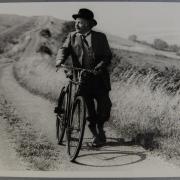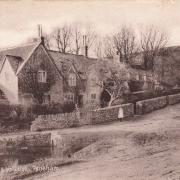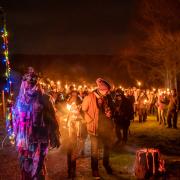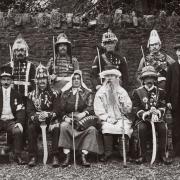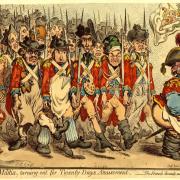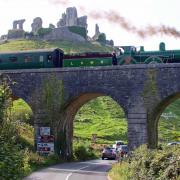Knitwear designer Justine Lee believes the future of sustainable fashion can be found in the fleeces of Britain’s purebred sheep, including the Dorset Down – whose fleece is woven into yarn by Dorset’s only spinning mill in Rampisham.
It wasn’t in the rolling green hills of Dorset that I first met Justine Lee, but at a craft fair in London’s Chelsea. Amongst the calfskin handbags and chiffon scarves, a montage caught my eye: neatly balled wool samples, the colours of pebbles on a beach.
Justine, a knitwear designer based in West London, has worked in the fashion industry for the last 30 years. Meaning that she knows wool like the back of her hand, from high-end to high street. But until recently she had no idea of the potential for wonderful knitwear, produced from Britain’s 62 varieties of purebred sheep.

‘Occasionally an agent would show me a British wool sample,’ Justine tells me, from her design studio in the garden. ‘Which would be coarse, twice as expensive as an Australian Merino and a dull cream colour.’
After she graduated, Justine’s first job was with Ballantyne Cashmere. At the time cashmere was an exclusive product, harvested from a couple of million goats kept by small herders in the mountains of Mongolia. Its expense comes from the fact that the wool is hand-combed from the underbelly of goats when they moult in the spring. ‘Today it’s still the same process, but cashmere has become fast fashion.’ Justine tells me. ‘For the farmers it’s highly lucrative, so exports have increased exponentially. But millions of goats are now encroaching on the fertile land of the Gobi Desert, pushing out food production. And Mongolia is at risk of famine because of it.’
Justine’s awakening to the damage caused by fashion came when she read Fashionopolis by Dana Thomas. ‘According to her, fashion sits somewhere between being the fourth and tenth most polluting industry, and the British buy more clothes per person than in any other European country – the majority of which is fast fashion.

‘We used to own an average 200 household items per person. Now it’s around 2,260. Including an average of 118 pieces of clothing, in comparison to just 25 in the 1970s. Which isn’t surprising, when you consider that a lambswool jumper can be bought from Primark for £15.99 and lasts a couple of seasons. Whereas a hand-knitted British wool jumper will last at least one generation, if not two.
The book inspired Justine to do an MA in sustainable textiles. Which is how she was introduced to the idea of knitting with wool from purebred sheep. On a visit to the British Wool Board she discovered that wool from British sheep is all mixed together to make yarns that are fine, medium or coarse. ‘I began thinking that maybe one of these individual yarns is really soft? Is there a cashmere sheep hiding in here?’
That same day, Justine bought a guidebook listing Britain’s 62 different pure breed sheep, then spent the next year collecting their wool and knitting a sample from each. ‘I’m pretty sure I’m the only person to have knitted every purebred sheep,’ she says. ‘Farmers loved sending me their wool, because no-one had shown an interest in it. The secret is that I separate out the best bits. Some of the sheep I’ve seen and felt do have an under-hair, especially older native breeds like the Soay and Wiltshire. They self-moult so don’t need sheering, and they also have this soft under-belly, just like the Mongolian goats. Although you end up using just half the fleece, you can make a wool as good as Merino and almost as good as cashmere. And you also have the heritage.’

There’s also a tremendous variety of colours within the different breeds - from black to brown; russet to stone grey; fawn to milk; and the yarns range from almost cashmere soft to carpet strong.
Part of Justine’s drive to find a sustainable way for knitwear is that she’s fearful of what’s coming for the British wool industry. ‘British knitwear companies already buy their wool from abroad at half the price they’re offered in the UK. And when the Australian trade deal arranged by Boris Johnson kicks in, in 15 years’ time, cheaper imports will create a possibly insurmountable problem for an industry that’s already struggling.
‘One farmer told me it costs him £2 to sheer a sheep. His 130 fleeces, sold to the Wool Board (who auction most of the UK’s wool), only fetched £1.44 per fleece. And it cost him £15 for delivery! Farmers must diversify if they’re going to survive, and I’m hoping that my approach with their wool will be an avenue worth exploring.’
Since graduating, Justine has turned her Masters’ research into a thriving knitwear business called Ossian, named after a collection of Celtic poems. ‘Working in Scotland for Ballantyne was my favourite job. I just loved the old stories that used to be told in the factories.’

Designs on the Dorset Down
After knitting her way through Britain’s purebred sheep, Justine found 12 that are soft enough to knit, one of which is the Dorset Down sheep. These were established in the 1800s, by crossing Downland Berkshire, Hampshire and Wiltshire ewes with pure breed South Downs. With an easy-going nature and early maturing lambs, they have thrived here.
‘The fleece is a soft short-fibred wool, dense and springy,’ Justine explains. ‘Because of its high quality and versatility, it’s often used in blends with other wools. You’ll also find it in knitting yarns and bedding – particularly Japanese futons.’
Justine uses Dorset Down wool, which she sources from Rampisham Hill Farm & Mill in Dorset, to fill her gilets; one of the staples of her collection. ‘The back and fronts take about 16 hours to hand-knit. I wash them and sew them together, then wash the garment again, put all the trims on and crochet the buttons.’
I’m amazed she can use a washing machine for these knits. ‘I deliberately knit looser, knowing that it will be handled a bit,’ she admits. ‘Washing brings it all together, making it slightly denser. Once that’s been done once, you can just throw it in – on 30 degrees with a spin rate of 400. Any more than that and you’ll completely felt it.’ She grimaces. ‘I’ve learnt from some painful mistakes.’

One of Justine’s favourite gilets was knitted for a regenerative farmer, using wool from her own flock of Masham sheep. ‘I knitted her ram logo into the back. I can knit anything into the design: words or pictures.’ She also produces knitting patterns and sells British wool on her website.
I ask what her favourite aspect of the business is. ‘I love the sourcing of the wool and meeting the farmers. I was at a farm recently and put my hand into a fleece and got very excited. That ongoing search for the cashmere sheep continues! I also love the designing and making.’
With entrepreneurs like Justine dedicated to making innovative change within the British wool industry, hopefully there is a brighter future? ‘Sheep are one of the things we do really well,’ she says. ‘We have the perfect terrain and an illustrious history that’s admired across the world – particularly in America and Japan.
‘I can see a real future for a range of British wools, produced on a commercial scale. However, we’re not being inventive enough. Jumpers made this way wouldn’t necessarily be cheap, probably around the £120 mark. But I believe everyone should aspire to own something that’s 100% British wool. It’s really the only way forward in terms of sustainably, both for British wool farmers, and the planet.’
For more information, visit ossianknitwear.co.uk

A New Generation of Spinning Mill Owners
Rampisham Hill Farm and Mill, near Beaminster, not only provides Justine with her gilet filling, but owners, David and Ruth Wilkins, also process all her fleeces into finished wool and yarn.
The couple bought the farm in 2007, where they established their flock of Dorset Down sheep. It was their passion for breeding quality stock and fine fleeces that led them to diversify into building a semi-worsted spinning mill.
The project took four years to research and design, seeing the installation of the latest computer-controlled textile machines, complemented by a couple of ‘lovingly restored’ machines from the 1930s. Three years on, it’s a thriving business specialising in processing smaller wool batches; ideal for smallholders, farmers and members of the hand-spinning, felting and crafting community. Commissions include a variety of finished products: from producing slivers and rovings (continuous snakes of fibre), batts (light ‘blankets’ of fibre) to finished spun yarns for hand-knitting and commercial sale.
For more information rampishammill.co.uk










